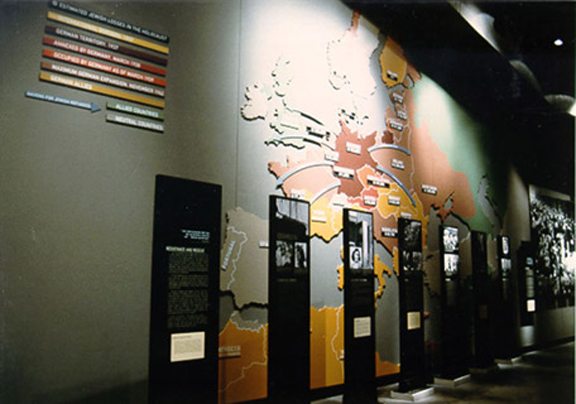
As I round the corner the wall seems to darken slightly in color and a large photo of a police controlled burning takes up about half the wall. In front of it, individual display panels suspended from the floors with the same iron beams and rivets found outside each display different photos. However rather than being on a flat plane with the wall, the displays are each angled in a different direction, forcing the viewer to interact with the photos as they move and relocate their body to allow them to fully view each image. The pictures displayed focus on the conditions that led to the rise of Nazi power and feature images such as a group of storm troopers surrounding Hitler, food lines from post WWI Germany, and a Nazi party rally.

Next to these pictures, a display reads, "Germany Under Hitler: a Police State" and we encounter many more pictures, similarly displayed at angles and featuring images such as officers rounding up socialists and communists and a picture of the Nazi Labor service lined up, looking almost exactly like soldiers, only holding shovels instead of guns. This hall seems to focus on the rise of Nazi power with the help of propaganda and the beginning of the discrimination of the Jews. Photos abound with images of the first attacks on the Jews, the Nuremburg trials, and the Ghettoization of the Jewish communities. At this point, the museum's interactive process becomes much more intense as more display technologies are used and viewers must encounter more and more shocking material.
Part of what makes this section so effective is its multiple use of displays to really encompass the viewer. As you move further down the hall, the ceiling begins to lower and feel more confining. A large display case holds books that are examples of the types of books burned by the Nazis. The books are presented on the display stand with an iron gated covering over the books that leaves squares about 5 inches by 5 inches through which I could stick my hand to really encounter the books; feeling their condition, flipping through pages, and encountering their age. This is the only place in the exhibit where visitors are encouraged to physically interact with objects from the period of the Holocaust and I found it particularly unique.
Next to the books, a large display is made up of a large picture of young German boys blowing horns in a Nazi parade. In the bottom left corner of the picture there is a Television screen with speakers showing footage from Nazi rallies and propaganda. Throughout the rest of the hall you can hear Hitler's voice and demanding speeches emanating from the TV's speakers. On the other side of the hall, a large display houses images of life in the ghetto and looking down below them, I encounter a small pathway made up of real cobblestones from the Warsaw Ghetto. More glass display cases house books and newspaper examples of Nazi propaganda. Others show old photos and postcards whose peeling corners and faded print serve as evidence to their age and authenticity. More cases display crumpled cloth Nazi armbands as well as yellow Jewish Stars the Jews were forced to wear.
In this part of the museum especially, it seems that the truth claim comes from huge amounts of physical evidence in the form of visual objects and artifacts. Other artifacts displayed include Nazi flags, identity cards, passports, immigration forms, Nazi dress daggers, and a hand embroidered baby dress. Worth noting in the artifacts is a letter in support of a German Jew's immigration to the US written by Imperial Sugar in Sugarland Texas. Like several other points in the exhibit, this particular object works to bring the viewer back to the context of Texas and Houston specifically. Above, a timeline style display shows the teaching of Nuremberg laws and images of facial measurements and people being measured to see if they are genetically Jewish. Above that, three large plasma screens display rotating images and texts showing Nazi power and persecution.

On the opposite wall, still part of the same hall, another large color coded map of Europe dominates the wall. This one is encoded to show how and when Germany controlled the various countries. Blue arrows point to havens for Jewish refugees while each country features a display with the number of estimated Jewish losses from that region in the Holocaust. In front, individual floor mounted displays each cover different topics such as, Resistance and Rescue, Fleeing Nazi Germany, False identity and Housing, Rescue, Resistance, Partisans, and Resistance in the Ghetto. Compared to the other Holocaust museums in my research, these topics were minimally addressed in the Houston museum. Other major absences from this section of the museum include a lack of discussion of the support for the Nazi’s given by the Catholic Church. Perhaps this is a function of the museum being privately funded (mostly by Jews) and their reluctance, as such, to make any offensive claims to "outside" groups. This second hall is the largest open space of the main exhibit and as such, is the only place that offers a bench in the middle for visitors to sit down, rest, and take in their surroundings. As the hall comes to an end the ceilings seem to be lower then ever and more shocking photos can be found featuring images of people kneeling at the edges of pits to be shot in the head by the Nazis behind them as well as images of soldiers aiming at a woman clutching her child to her chest. This part of the museum also does a good job, where many other Holocaust museums fail, in portraying the non-Jewish victims of Nazi oppression. A large display houses a discussion with images of the murder of Slavs as well as a discussion of the Euthanasia program whereby Nazis began sterilizing all Germans ill from hereditary disease or handicapped.
